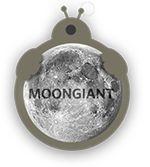Understanding Moon Phases
Let’s start with some interesting facts. It takes the Moon 29.53 days to orbit completely around the Earth in a full lunar cycle. During this time, the Moon will go through each phase. Since the Moon’s orbital journey takes a little less than a full month, when you click on future dates you’ll notice that–depending on the exact number of days in that month–the Full Moon occurs a day or two earlier each month.
It’s the Moon’s journey as it orbits around Earth that creates the predictable dance between light and shadow. And while the changes may seem slow, on any given day the amount of Moon illuminated by the Sun can vary by as much as 10-percent. The illustration above shows the range of illumination for today - April 27, 2024. The illustration is set to your computer’s clock and therefore gives you an accurate reading for your own particular time zone.
The four main Moon phases in order are the New Moon, First Quarter Moon, Full Moon and Last Quarter Moon. These phases occur at very specific times and are measured by both the Moon’s luminosity and how far along the Moon is in its orbit around Earth.
The New Moon Phase occurs when the Moon is completely dark with zero-percent luminosity, while the Full Moon Phase is completely bright with 100-percent luminosity. The First and Last Quarter phases happen when the Moon is exactly half illuminated, with 50-percent luminosity. When people say “today is a Full Moon” it’s important to remember that doesn’t mean the Moon is full all day long, only that the Full Moon Phase occurs on this day. In reality, the exact moment of the Full Moon can be timed to the second. To learn more about the exact time of the Full Moon and the current Full Moon info, check out these Current Full Moon times.
The remaining four Moon phases occur at halfway points between the main phases. Unlike the main phases, these minor phases don’t happen at a specific time or luminosity, rather they describe the Moon’s phase for the entire time period between each main phase. These interim phases are Waxing Crescent Moon, Waxing Gibbous Moon, Waning Gibbous Moon and Waning Crescent Moon. The illustration below shows all eight main and minor Moon phases and where they occur in the lunar cycle.
Moon Phases In History
Imagine a Neanderthal peering out of his cave some dark summer night as the Full Moon rises above the horizon. Nothing on Earth was quite like this strange brilliant object arcing through the night sky. What did he think it was? It’s not hard to imagine how the Moon became the source of many religions, myths and legends throughout the ages.
The Greeks were among the first to take a scientific look at the Moon and her phases. Around 500 BC Greek philosopher and astronomer Pythagoras carefully observed the narrow boundary line—the terminator—between the dark and light hemispheres of the Moon. Based on how the terminator curved across the surface of the Moon, he correctly surmised the Moon must be a sphere.

A few centuries later, around 350 BC, Aristotle took Pythagoras observations even further. By observing the shadow of the Earth across the face of the Moon during a lunar eclipse, Aristotle reckoned that the Earth was also a sphere. He reasoned, incorrectly however, that the Earth was fixed in space and that the Moon, Sun and Stars revolved around it. He also believed the Moon was a translucent sphere that traveled in a perfect orbit around Earth.
It wasn’t until the 16th century that our understanding of the Solar System evolved. In the early 1500s Astronomer Nicolaus Copernicus developed a model of the Solar System where Earth and the other planets orbited around the Sun, and the Moon orbited around Earth. One hundred years later Italian Astronomer Galileo used one of the first telescopes to observe the terminator and deduced from the uneven shadows of the Waning Crescent Phase that the Moon’s surface was pocked with craters and valleys and ridged with mountains.
These observations were revolutionary. Copernicus and Galileo upended the long-held Aristotelian view of the heavens as a place where Earth was the center of the Universe and the Moon was a smooth, polished orb. Telescopes and new minds helped scientist understand that the Earth and planets orbited around the Sun and the Moon was a battered and cratered satellite held in our own orbit.

